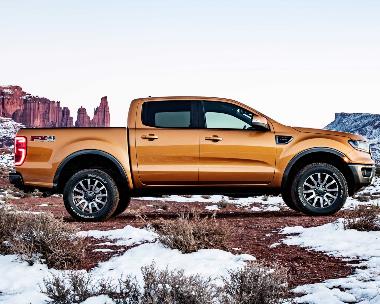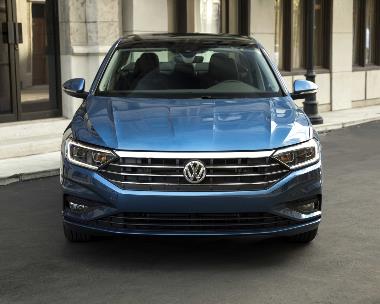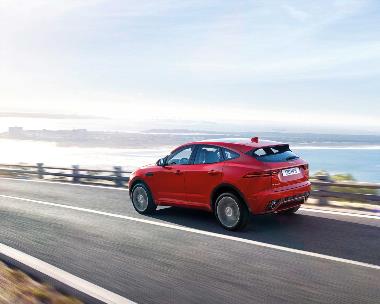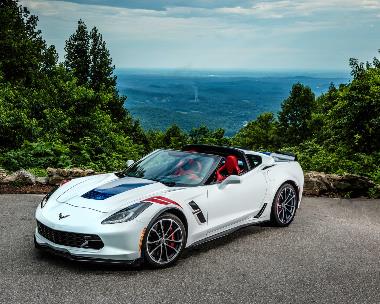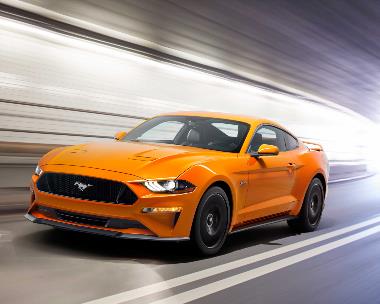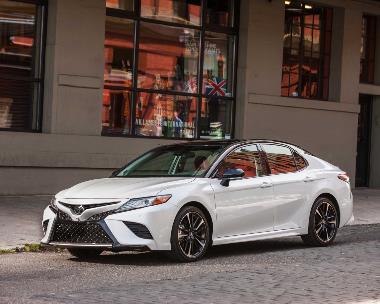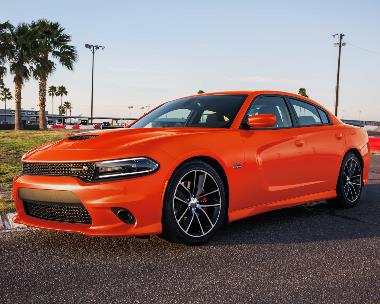-
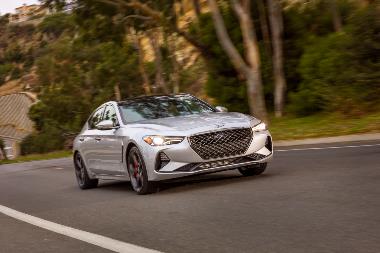
2019 Genesis G70: Luxury Brand Branches out with New 4-Door Compact Executive Performance Sedan
Thursday, Jan 31, 2019
In 2004, Hyundai chose to expand from the “econocar” ranks and enter the luxury market with Genesis, which was promoted as the first chapter of pre …
Show MoreIn 2004, Hyundai chose to expand from the “econocar” ranks and enter the luxury market with Genesis, which was promoted as the first chapter of premium cars to be manufactured by the South Korean, multinational automaker. Since its launch for the 2009 model year, Genesis was accepted as a luxury vehicle without a luxury price and without a hyped luxury nameplate. In 2017, Hyundai spun off its Genesis line as its own luxury-car badge, and for 2019, Genesis launches G70, Genesis Motors’ third model, a 4-door compact executive luxury performance sedan. And from the get-go, G70 has reaped awards and positive buzz.
The 2019 Genesis G70 has already been named: “The 2019 North American Car of the Year” by a jury of industry experts at the Detroit Auto Show; “2019 Car of the Year,” by Canada-based AutoGuide.com; “2019 GOOD DESIGN®” by The Chicago Athenaeum Museum of Architecture and Design; and it also received a “Top Safety Pick+” rating by The Insurance Institute for Highway Safety (IIHS).
Designed and engineered to offer driver-focused performance, refined luxury, advanced technology, and a world-class ownership experience, Manfred Fitzgerald, former Director of Brand and Design at Lamborghini, and now Global Head of the Genesis brand said, “The G70 is all about the driver’s experience. We look forward to how our youngest and most dynamic sedan will connect with our clientele through refined performance and athletic elegant design.”
G70 rounds out the Genesis brand’s sedan lineup, joining the G80, G80 Sport, and its flagship G90, and the brand will continue to expand its product portfolio to all echelons of the luxury auto market. Packed with interior tech and comfort, and exterior grace, G70 comes with a choice of powerful and refined turbocharged engines: 2.0-liter inline four-cylinder or a 3.3-liter V-6; available driver-focused features including Genesis Active Safety Control, limited-slip differential, Michelin® Pilot® Sport 4S tires and Brembo® brakes; available 6-speed manual gearbox (2.0T RWD model); and Genesis Connected Services that provide advanced telematics with seamless connectivity directly into the vehicle, with technology that includes Destination Search powered by Voice, Car Finder, Enhanced Roadside Assistance, and Stolen Vehicle Recovery. With a complimentary three-year subscription, Genesis Connected Services further enhances peace of mind for drivers and passengers, with SOS Emergency & Automatic Collision Notification.
Design wise, the G70 represents the future direction of the Genesis brand’s “Athletic Elegance” design signature. Its long hood and short overhangs, dynamic roofline, and high beltline characterize a sleek profile. In the side view, the parabolic character line displays kinetic form language with voluptuous curves and smooth surfaces. Like its sedan stablemates, the G70 features the Genesis Crest Grille with distinctive linear LED daytime-running lights. Built on the same platform that houses the Kia Stinger, but with a wheelbase that’s 2.8 inches shorter than its hatchback cousin, G70 measures 184.5 inches long, 72.8 inches wide and 55.1 inches high on a 111.6-inch wheelbase, and weighs in with a curbweight of 3847 lbs.
Inside, the G70’s interior delivers a driver-focused experience with high quality materials and unparalleled attention to detail. Genesis designers specified genuine brushed aluminum surfaces, quilted Nappa leather seats, stainless steel speaker grilles, and premium stitched soft-touch surfaces throughout the interior. An optional 15-speaker Lexicon high-fidelity audio system with QuantumLogic® surround-processing technology transforms any audio source into a rich and immersive listening experience.
The G70 cabin is well-appointed, but a bit cramped, and the rear seats accommodate two passengers more comfortably than three. Front headroom is a bit tight if you are over six-feet tall, at 39.7 inches, while legroom is roomy at 42.6 and shoulder room is 56.3. Rear accommodations are even tighter with head room of 36.9 inches, legroom is 34.8 and rear shoulder room is 54.6.
G70 is available with three powertrain configurations and five trim packages, and a choice of two engines: a 252hp/260 lb-ft torque, 2.0-liter turbocharged inline four-cylinder (22mpg/city and 30mpg/highway), and a 365hp/376 lb-ft 3.3-liter twin-turbocharged V-6 (18mpg/city and 25mpg/highway). I averaged 19.6mpg in my 3.3.
The manufacturer says the Genesis 3.3 will run a 4.5-second zero-to-60mpg sprint, and my test Genesis, tuned as one you would get from a dealership, managed a 4.9-second sprint and a 13.5-second (hand-timed) quarter-mile. And on the highway and around town, Genesis delivered a stable ride with solid balance and attentive handling. Rough winter roads were felt in the seats, and steering was vague at times, while tire noise did enter the cabin a bit, but G70 offered power when asked, and long interstate drives were fun and indulgent.
The 2019 Genesis G70 3.8 starts at $34,900 with the 2.0-liter engine in RWD and $36,900 in AWD. The 3.3-liter twin turbo model starts at $43,750 in RWD and $45,750 in AWD as was my test ride. In Santiago Silver, with a Black-Gray interior, my review vehicle added the 3.3T Prestige Package for $4250, with Heads-up Display, Surround View Monitor, Nappa leather seating surfaces with luxury quilting, heated rear seats, Microfiber suede headline, Low Beam Assist, Rain-sensing wipers, Parking Distance Warning, Wide sunroof and Wireless charging pad. Mud/splash guards added $60, and a clear vinyl rear bumper appliqué added $70, for a sticker of $51,125.
Visit www.CarlisleEvents.com for more on the automotive hobby.
Mike Blake, former editor of KIT CAR magazine, joined Carlisle Events as senior automotive journalist in 2004. He's been a "car guy" since the 1960s and has been writing professionally for about 30 years.
-
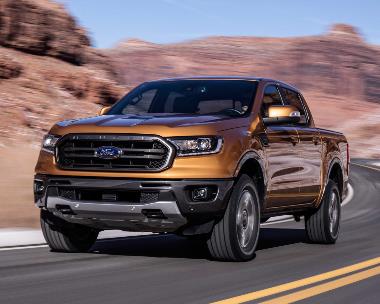
2019 Ford Ranger: Midsize Pickup is Back and it’s Tough, Sporty and Versatile
Wednesday, Jan 16, 2019
Pickup truck sales continue to increase – expected to exceed 2.8 million in US sales this year – and the midsize truck segment went over half-a-mil …
Show MorePickup truck sales continue to increase – expected to exceed 2.8 million in US sales this year – and the midsize truck segment went over half-a-million last year, so Ford, the perennial truck-selling champ, has re-entered the midsize segment competition by bringing back Ranger. After an eight-year hiatus, the Ford Ranger is back and touted by Ford as “most fuel-efficient gas-powered midsize pickup in America.”
Ford’s Ranger began its truck life in 1965 as a Ford F-Series trim package, and became its own compact pick-up line in 1983, replacing the Ford Courier. The compact Ranger ceased production in 2011 for the U.S. and Canada, but began globally as an international mid-size pickup. Well, Ranger is back in the US as a versatile midsize -- it can be configured with several cab and bed sizes, to 2x4, 4x4, and with off-road, in-town or hauling-load capabilities.
The old Ranger was a small, rather pedestrian truck. The new Ranger is larger, tech savvy, infotainment rich, upscale and ruggedly sporty, with workhorse attributes. Ranger is all-new and all-modern, inside and out. Its body-on-frame construction (an all-steel frame and steel bumpers) is sculpted into a muscular body with a high beltline, raked grille and windshield to increase aerodynamics and reduce wind noise while taking on an athletic demeanor; and short overhangs mean better approach and departure angles and improved off-road capability.
Available in three trim levels (X, XLT and Lariat) in either rear-wheel-drive or 4x4, Ford Ranger is assembled at the Michigan Assembly plant in Wayne, Michigan. With a 126.8-inch wheelbase, 210.8-inch length 85.8-inch width and height ranging from 70.7 to 71.5-inches depending on configuration, Ranger has a running ground clearance of 8.4 to 8.9 inches (depending on configuration) and curb weights of 4145 to 4441 lbs. Towing capacity maxes out at 7,500 pounds, and its payload is rated at 1,860.
Ranger has not spared the muscle … especially for a mid-size. While a 335-hp Ranger Raptor may be available in 2020, the 2019 Ranger shows plenty of brawn. Powered by an aluminum 2.3-liter EcoBoost® I-4 with Auto Start-Stop, mated to a 10-speed SelectShift® automatic, the system puts out 270hp and 310 lb-ft of torque, for an EPA-estimated fuel economy rating of 21 mpg city, 26 mpg highway and 23 mpg combined. My week of winter-condition testing realized an average of 23.3mpg.
With little turbo lag, my heavily feature-filled test Ranger smoked the pavement to a 7.2-second zero-to-60 sprint during a 15.6-second (hand-timed) quarter-mile. Uphill grades were conquered easily and passing at speed is no prob. Steering is more carlike than trucklike, and while you do get sway during high-speed or autocross maneuvers, feedback is good for the segment. That helps translate into a gentle driving and passenger experience, as the short- and long-arm independent front suspension with tubular stabilizer bar works well with the Hotchkiss-type non-independent rear with live, leaf springs and outboard shock absorbers to smooth out pavement irregularities, while allowing for off-road feel and success on odd terrain.
Interior space is supple with front headroom of 39.8 inches, front legroom of 43.1 and front shoulder room of 56.6. With seating for five, rear measurements are headroom: 35.9, legroom: 30.4 and shoulder room: 55.3. Quiet inside, Ranger is refined, with little road noise, no squeaks, rattles or typical truck noises; and a host of niceties. The cabin is equipped with dual zone air conditioning, SYNC® 3, infotainment, Android Auto, Apple CarPlay, 8-inch touch screen, power windows and mirrors, and heated seats.
Safetywise, Ranger utilizes standard Pre-Collision Assist with Automatic Emergency Braking; a Lane-Keeping System that includes lane-keeping assist, lane-departure warning and reverse sensing; and class-exclusive Blind Spot Information System with trailer coverage; all standard on XLT and Lariat. Adaptive Cruise Control is standard on Lariat. Ranger is also outfitted with dual-stage driver and right-front passenger front airbags; front-seat side airbags and a Safety Canopy® System with side-curtain airbags and rollover sensor. You also get Automatic Emergency Braking, Anti-Lock Brake System, rear view camera, Remote Keyless Entry with remote tailgate lock, SecuriLock® Passive Anti-Theft System, SOS Post-Crash Alert System™, Tire Pressure Monitoring System and trailer sway control.
The 2019 Ford Ranger starts at $24,300 for the base XL with SuperCab, 6-foot box and 4x2. The XLT starts at $27,940 and the upscale Lariat starts at $32,210. My test XLT went to the Super Crew Cab and 5-foot-box for an extra $2175. I need 4x4 drive stability and upgraded from 4x2 for an additional $4000. My Ranger was covered in Saber (Burnt Orange) paint as part of the $1790 301A package that added an auto-dimming rearview mirror, leather-wrapped steering wheel and shifter, folding sideview mirrors with power glass, and SiriusXM® Satellite Radio, SYNC® 3. Package 302A was also added for $2800 – we got 8-way power driver and passenger heated seats with power lumbar, manual sliding rear window, remote start and a Sport Appearance Package with lots of cool cosmetics. The bed utility package with bedliner added $395, and the $795 Technology Package added a number of technology features including navigation and Adaptive Cruise Control. Front and rear splash guards were $130, and destination charges were $1195, for a sticker-as-tested of $39,430.
Visit www.CarlisleEvents.com for more on the automotive hobby.
Mike Blake, former editor of KIT CAR magazine, joined Carlisle Events as senior automotive journalist in 2004. He's been a "car guy" since the 1960s and has been writing professionally for about 30 years.
-

2019 Mercedes-Benz C300: Refreshened with Fluid Design and Added Power and Tech
Wednesday, Jan 9, 2019
Mercedes-Benz is on the move with new designs, enhanced interiors and exteriors. Going with creaseless, smooth architecture and luxurious cabins wi …
Show MoreMercedes-Benz is on the move with new designs, enhanced interiors and exteriors. Going with creaseless, smooth architecture and luxurious cabins with infotainment centers, Mercedes-Benz is refreshening this year. The manufacturer touts the tweaks as “combining emotion with intelligence.”
Among the refreshed lines is the 2019 C-Class Sedan also enhanced with increased power and extended driver assistance systems. Among the highlights are a redesigned front end, newly designed LED headlamps and taillamps, a new, more powerful, and efficient engine that increases output by 14 horsepower, and the extended suite of Intelligent Drive features shared with the Mercedes-Benz E.
Introduced in 1993 as a replacement for the M-B 190, the C-Class was the smallest (at the time) class in the Mercedes-Benz arsenal, and it is currently Mercedes-Benz's top-selling model.
Exterior changes for this year include redesigned front and rear bumpers, and the vehicle equipped with AMG-Line features, get a diamond radiator grille as standard. The front bumper presents a chrome-plated trim as part of the standard vehicle. The rear bumper on the Sedan has a new lower section – its geometry, trim and tailpipe trim vary according to the selected equipment. And you get power-folding side mirrors.
The design of the headlamps and taillamps is defined by clear-lined contours. Exquisitely crafted details add highlights and underscore the C’s modern character, and the C-Class is now equipped with LED headlamps and taillamps as standard. An LED Intelligent Light System with High Performance headlamps and ULTRA WIDE high beam is optionally available.
With steel unibody, aluminum outer sheet metal construction, the C300 measures 184.5 inches long, 71.3 inches wide and 55.3 inches high on a 111.8-inch wheelbase. Ground clearance is 3.5 inches, and we scraped a few times during tests.
The sporty interior is elegant, featuring flowing forms in a new interpretation of modern luxury. The center console is characterized by an elegant graceful trim, now available in Natural Grain Walnut Wood or Natural Grain Grey Oak Wood. The 3D real wood veneer in the center console combines a hand-crafted character with a modern feel. Magma Grey/Black upholstery is newly available for the interior, as is Saddle Brown and Silk Beige/Black for the AMG-Line Interior. The KEYLESS START function is standard and the start/stop button comes in a new turbine-look design. The vehicle key also features a new design.
Inside, C300 offers 44.0 inches of front legroom, but only 26.0 inches in row two. Shoulder room is 54.8 in front and 51.7 inches in row two, But those confines are packed with such standard items as power front seats with driver-seat memory, power tilt/sliding tinted glass sunroof, dual-zone automatic climate control, 40/20/40 split-folding rear seats, SmartKey, analog gauges with high-resolution multifunction display, 7-inch high-resolution central display, 3-spoke steering wheel with Touch Control Buttons, central controller, Bluetooth audio streaming, dual USB audio ports, HD Radio receiver, FrontBass® system, Apple CarPlay and Android Auto.
Gaining 14hp over last year, the C300, C300 4MATIC both come with 255hp in-line 4-cylinder engines, and the 385hp V-6-powers AMG C43 trim. Torque estimates are 273 lb-ft for the 2.0-liter in-line 4 and 384 lb-ft for the 3.0-liter V-6.
My 2.0-liter was matched to a 9G-TRONIC 9-speed automatic transmission and was rated at 22mpg/city, 31mpg/highway and 25mpg combined. My tests yielded an average of 24.6mpg.
Given a factory estimate of 5.9 seconds for a zero-to-60 sprint (the 3.0-liter V-6 is manufacturer-estimated at 4.5 seconds), inclement weather canceled track tests, but last year’s tests with the smaller-hp engine (241 hp) showed 6.8 seconds and a 15.2- quarter-mile, and this year’s more powerful (by 14hp) engine seemed quicker and accelerated smoothly. Power was always there when called upon.
From a safety perspective, C300 pays attention with front-impact airbags, side impact airbags, overhead airbags, knee airbags, seatbelt pretensioners , anti-whiplash head restraints, anti-lock brakes, stability control and a security system that has a means of anticipating and/or detecting unwanted vehicle intrusion. The vehicle is equipped with an ignition disable device that will prevent the engine from starting if the correct original manufacturer key is not used.
The 2019 Mercedes Benz C300 sedan bases at $41,400 in Black or Polar White – other colors will cost extra. My test ride was bathed in Selenite Metallic (dark gray) for an extra $720. AMG styling starts at $2000 extra, but mine was a base C300. The Exterior Lighting package adds Intelligent Light System with Ultra Wide Beam headlamps and Adaptive Highbeam Assist for $900. A rear spoiler added $300; cool LED logo light projectors added $200; Magma Grey leather upholstery in the Leather Seating Package with Memory for front passenger seat added $1950; Heated front seats were $580; Heated Steering Wheel was $250; the Multimedia Package with COMMAND navigation, touchpad controller, enhanced voice control, Car-to-X Communication and a 10.25-inch high-resolution center display added $2600; a panorama roof added $1000, inductive wireless charging and NFC pairing added $170, and the $2250 Driver Assistance Package added active distance, steering and evasive steering assist, brake and cross traffic assist, emergency stop, speed limit, blind spot and lane change assist, for a sticker-as-tested of $51,930.
Visit www.CarlisleEvents.com for more on the automotive hobby.
Mike Blake, former editor of KIT CAR magazine, joined Carlisle Events as senior automotive journalist in 2004. He's been a "car guy" since the 1960s and has been writing professionally for about 30 years.
-

2019 Volkswagen Jetta 1.4T: Fun to Drive, Larger and More Coupelike
Wednesday, Jan 2, 2019
We begin our coverage of 2019 models with the new, seventh-generation 2019 Volkswagen Jetta. VW’s best-selling car was once offered in sedan and ha …
Show MoreWe begin our coverage of 2019 models with the new, seventh-generation 2019 Volkswagen Jetta. VW’s best-selling car was once offered in sedan and hatchback configurations, but is now only presented as a sedan.
For the 2019 model year, the Jetta is based on Volkswagen’s Modular Transverse Matrix (MQB) platform architecture. Working with the flexible MQB platform allowed the designers to reshape the body, creating a longer wheelbase, wider track, and a shorter front overhang. The fast-sloping rear roofline translates into a coupe-like profile. Dynamic lines and taut surfaces combine with the new silhouette to give Jetta a look that is elegant, yet athletic.
Compared with the outgoing generation, Jetta grows outside in every direction. It is longer, wider and taller than the outgoing model. The increased exterior proportions add up to more interior space than the previous car as well. While larger than earlier editions, Jetta is still compact at 185.1 inches long (1.8 inches longer), 70.8 inches wide (an increase of 0.8 inches) and 57.4 inches high (0.2 inches higher) on a 105.7-inch wheelbase (a gain of 1.3 inches), with a ground clearance of 5.8 inches (up 0.6 inches). Jetta seats five and weighs in at a light 2970 lbs, 220 lbs lighter than before, for the automatic transmission version.
The new front end design, with its emphasis of horizontal lines still identifies with VW. Specific to the model is the distinctive unit formed by the radiator grille and the standard LED headlights. The trapezoidal grille is composed of four chrome bars, two of which flow into the headlight housings where the LEDs pick up the lines and connect them for a wrap-around effect.
The car's silhouette is marked by its taut surfaces and a long, extended side window. The coupe-like impression of Jetta is reinforced by an offset roofline known as a 'phase'—a narrow strip that runs parallel to the actual roofline and into the C-pillar—which visually reduces the car's height.
Jetta’s upscale driver-centric interior architecture has been redesigned, having been engineered for increased comfort while supporting a sophisticated, upscale design. The 2019 Jetta has more headroom, knee room, and shoulder room than the previous car, and both the instruments and the infotainment system are arranged in an easy-to-read horizontal orientation.
The cabin is accommodating with an un-compactlike at 38.5 inches of front headroom (a gain of 0.3), with 37.2 inches in row two (up 0.1); shoulder room is 55.9 inches in front (0.7 inches more than last year) and 54.0 inches in the rear (up 0.4); while legroom is marginally tighter, but still a comfortable 41.1 inches for row one and 37.4 inches for the second-seat passengers. Trunk room has shrunk from16 cu.ft. to 1 cu.ft.
Fun to drive, Jetta’s 1.4T is powered by the base 1.4-liter inline four-cylinder turbocharged/intercooled engine that provides 147hp and 184 lbs.-ft. of torque. A 2.0-liter 220hp turbo engine will be available in the GLI trim for 2020.
Both the six-speed manual and the eight-speed automatic versions are rated well with the automatic EPA-rated at 30mpg/city, 39mpg/highway and 34/combined for the 1.4. The manual tops at 40mpg highway. My week of tests in the automatic averaged 33.3mpg.
My automatic SEL Premium trim accelerated and turbo’d-in seamlessly, and delivered solid acceleration off the line. Speed increase was predictable and reliable when needed, and rack tests showed a 7.6-second zero-to-60mph sprint and a 16-second quarter-mile.
My Jetta handled consistently, but quick acceleration and turns resulted in severe body lean. The rack-and-pinion, electric steering with power assist was a bit vague, but all in all, in varied tests, Jetta was balanced and responsive for the niche.
Building on its rep as a top safety vehicle, the 2019 Jetta offers a combination of both passive and active safety systems that are engineered to meet or exceed current crash regulations. And Jetta’s MQB chassis is a much more rigid architecture than the previous version, which pays dividends in safety for both passengers and pedestrians alike. Highlights include a rigid laser-seam-welded bodyshell, crash-optimized, energy-absorbing front end, and heat-formed steel center B-pillars.
The base 2019 Jetta S 1.4T starts at $18,545, followed by the 1.4T SE at $22,155 (adding a Panoramic sunroof and keyless push-button start); the R-Line at $22,995 with special alloy wheels and two-tone leatherette seating; the SEL at $24,415 with 10-color interior ambient lighting, BeatsAudio® and VW Digital cockpit added; and the SEL Premium starting at $26,945 with metallic alloy wheels and premium finish, 8-inch touchscreen navigation, leather seating surfaces and ventilated front seats.
My test Jetta SEL Premium was bathed in Silk Blue Metallic exterior paint, mated to a Titan Black Leather interior. I prefer a manual transmission in sports cars, but my test ride was outfitted with an 8-speed automatic with Tiptronic® and Sport mode as standard for the trim level. Monster Mats® (great for mud and winter weather) added $105; and MuddyBuddy® trunk liner added $105. Side window deflectors added $135; splash guards added $116; Auto-dimming mirror with HomeLink® added $285; Bumperdillo® rear bumper protector added $110; and destination charges added $895, for a sticker-as-tested of $28,696, to start 2019 under $30K.
Visit www.CarlisleEvents.com for more on the automotive hobby.
Mike Blake, former editor of KIT CAR magazine, joined Carlisle Events as senior automotive journalist in 2004. He's been a "car guy" since the 1960s and has been writing professionally for about 30 years.
-
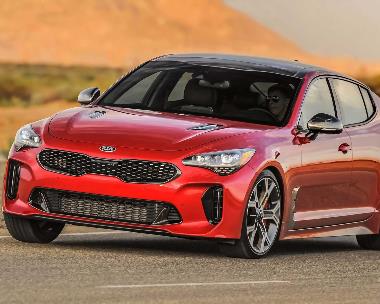
2018 Car of the Year: Kia Stinger: New Sports Sedan is Powerful and Luxurious
Wednesday, Dec 26, 2018
Last week, our “Car Buy of the Year,” Top-10 list focused on the “best bang for the buck,” with the 2018 Hyundai Kona winning top honors. This week …
Show MoreLast week, our “Car Buy of the Year,” Top-10 list focused on the “best bang for the buck,” with the 2018 Hyundai Kona winning top honors. This week, we present our “Car of the Year” list, in which we concentrate on the best car, truck, crossover or SUV and what it delivers, regardless of price – just the pure vehicle – and how it feels to be behind the wheel.
For our 14th annual Car of the Year list, we see new models, sports-luxury cars, iconically badged SUVs, legendary sports cars, nostalgic muscle cars, Eurocars, sporty sedans, a luxury sedan and even an econo-compact SUV.
My rules: To make this list, I must have test driven the car in calendar 2018 and it must have stood out from the pack, surprised me, impressed me, and satisfied the “car guy” in me, as well as amaze any passengers or onlookers who rode in or saw the vehicle.
I test drove 54 different vehicles this year, and after a weeklong (in most cases) assessment as a daily driver and/or track car, I graded each ride in the following categories: Interior; Safety; Power; Handling/Ride; Economy/Price; Looks; Niche-fitting and a Miscellaneous grouping in which I took into consideration the “feel-good” factor and other intangibles. Each category had its own integrity and encompassed such items as driver intuitiveness, comfort, easy-to-read instrumentation, quietness and ease of surroundings. In each category I award from zero to 10 points (10 being perfect)..
Last year, a Lexus LC 500 luxury Coupe won the title, and this year, an all-new mid-size luxury sedan from a traditionally non-luxury badge combined elegance and power, performance and grace to take the crown. Prices reflect sticker-as-tested.
No. 1 Kia Stinger: Dynamic new sports car combines athleticism and luxury -- $53,255
Kia has come a long way, and with the all-new 2018 Kia Stinger, the manufacturer has entered the mid-size luxury four-door sports car segment debuting an athletic, bold, adventurous performance car with luxurious accommodations. From its sleek front clip through its graceful sides and slender shoulders, Stinger exudes a muscular confidence. Inside, Stinger exudes an aircraft-like feel filled with upscale accouterments. It is powered by a 3.3-liter twin-turbo V-6 with 365 hp and 376 lbs-ft. and it blazed a 4.7-second zero-to-60mph dash and a 13.2-second quarter-mile. My test Stinger GT2 averaged 22.0mpg in mixed-use driving, and exhibited solid sportscar exuberance, acceleration and handling.
No. 2 Jaguar E-Pace: Compact luxury SUV with the look and feel of a ‘Cat -- $55,110
An all-new compact-luxury crossover with a Catlike look indicative of its Jaguar DNA, E-Pace packs the design and performance of a Jaguar sports car into a practical and connected all-wheel-drive vehicle with SUV practicality. E-Pace features a four-cylinder Ingenium gasoline engine that delivers 296 hp and 295 lb-ft of torque. At the track, I zipped from zero-to-60mph in an impressive 6 seconds flat during a 14.5-second quarter-mile. My mixed-use tests averaged 23.3 mpg.
No. 3 Corvette Grand Sport: Blazing hot and super cool on highway or track -- $82,715
Finishing third for the second straight year, the Corvette Grand Sport borrows from Stingray design cues with a touch of Z06, including the front grille and wider rear fenders, which give it an aggressive stance and a wide track. High tech and luxurious inside, performance is key as the 6.2-liter V-8 roars out 460hp and 465 lb-ft of torque and rocketed to a 3.9-second zero-to-60mph sprint and 12.3-second quarter-mile. My tests averaged 16.3 mpg.
No. 4 2018 Chevrolet Camaro ZL1: Historically powerful, hot and fast -- $72,515
The most powerful Camaro ever, and highest hp on this list, my 2018 Camaro ZL1 and its 650 horses/650 lb-ft of torque blazed the dash in 3.4 seconds (hand-timed), and finished off a quarter-mile in 11.4 seconds. Traditional Camaro styling lives on with a muscular and sporty architecture, sculpted creases, a proud undergrille, a low and wide stance and enhanced interior packed with infotainment. Camaro’s structure and balance was race-car precise.
No. 5 Ford Mustang GT: More Pony Power and enhanced exterior and tech -- $45,875
Also last week’s No. 7 CAR BUY of the YEAR, the Ford Mustang GT has tweaked up with a sleek new design, more advanced tech and improved performance enhancements. The 5.0-liter V-8 provides 460hp and 420 lb-ft and can be mated to 10-speed transmission. On the highway, you have ground-hugging stickiness and cornering confidence. Muscular and attentive, I dashed from zero to 60mph in 4.7 seconds during a 13.3-second quarter-mile, and I averaged 18.2mpg in mixed-use tests.
No. 6 Volvo XC60: Full redesign, new safety suite for premium mid-sized SUV -- $52,070
Volvo XC60 has been completely redesigned for 2018. XC60 keys in on safety with Volvo’s ground-breaking City Safety system, and there’s enhanced driver infotainment, a new exterior and new CleanZone four-zone climate system that removes harmful pollutants and particles from outside to deliver fresh air on the inside. Its 2.0-liter 4-cylinder engine that provides 250hp and 258 lb-ft of torque got me 22.2 mpg and finished off a sprint in 6.9 seconds and a quarter-mile in 15.3.
No. 7 Toyota Camry: Midsize family sedan evolves with sportscar tendencies -- $38,017The all-new eighth-generation Toyota Camry is an established mid-size family sedan that has turned into a sports car … of sorts. Redesigned with a sporty and upscale image both inside and out, and longer, wider and closer to the ground for increased ride dynamics, its 3.5-liter engine is rated at 301hp and 267 lb-ft of torque. A zero-to-60mph dash was accomplished in a smooth 5.8 seconds during a 14.4-second quarter-mile. Fuelwise, I averaged 26.7mpg in mixed-use tests.
No. 8 Hyundai Kona: Sub-Compact CUV marketed to youthful driver-adventurers -- $29,805
The lowest-priced and lowest-hp vehicle on this week’s list was also last week’s No. 1 CAR BUY of the YEAR. Hyundai has targeted youthful “urban adventurers” with its all-new sub-compact crossover utility vehicle, the 2018 Hyundai Kona. With aggressive body styling, a sporty demeanor, top-of-the-line safety technology and advanced infotainment features in a compact footprint, Kona handles well and its 1.6-liter turbo generates 175 hp and 195 lb-ft of torque for an average of 26.7 mpg.
No. 9 Dodge Charger: America loves its muscle, then and now -- $41,500
Drawing on cues from the historic 1969 model, Dodge Charger is America’s only four-door muscle car and the sales leader in the large car segment for five years running. This year’s model gets new cosmetics, interior upgrades, wheel packages and colors on various models. The 5.7-liter HEMI V-8 that powered my R/T trim Charger stampedes out 370 horses and 395 lbs-ft of torque, averaged 22.2mpg and completed a zero-to-60mph sprint in 6 seconds during a 14.4-second quarter-mile.
No.10 Buick Regal GS: More powerful, sportier and upgraded cabin -- $44,255
Buick has gone all-new with Regal in 2018, with a sleek, sporty design increased horsepower, an upgraded cabin and advanced infotainment. Buick offers a sculptured Euro-sportiness with aggressive front and rear fascias, unique GS-specific cabin additions, and an aluminum 3.6-liter direct injection V- 6m rated at 310hp and 282 lb-ft of torque. My week of mixed-use tests yielded an average of 20.7mpg and my zero-to-60mph time was 5.5 seconds during a 14.5-second-flat quarter-mile.
Next week we begin coverage of the 2019s, and we start learning about next year’s best cars.
Visit www.CarlisleEvents.com for more on the automotive hobby.
Mike Blake, former editor of KIT CAR magazine, joined Carlisle Events as senior automotive journalist in 2004. He's been a "car guy" since the 1960s and has been writing professionally for about 30 years.
Book with a preferred Hotel

Book online or call (800) 216-1876

